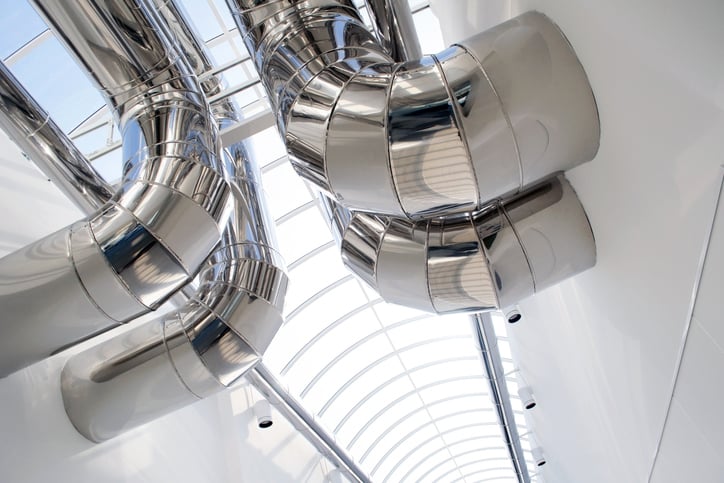NDIR CO2 Sensors: Single- Vs. Dual-Channel in HVAC Systems

Carbon dioxide is an inescapable part of our lives.
And, with indoor air quality (IAQ) being a top priority in all building types, keeping CO2 at safe levels is now an expectation for HVAC system functionality.
When it comes to CO2 detection and mitigation via HVAC systems, one sensor type stands above all others: NDIR (non-dispersive infrared) sensors.
Why?
Several of the defining performance characteristics that are hard for any HVAC manufacturer or system designer to ignore:
Accurate. Long-lasting. Reliable. Adaptable.
What is an NDIR CO2 Sensor?
An NDIR CO2 sensor is a type of gas sensor that uses infrared (IR) technology to detect the concentration of carbon dioxide (CO2) in the air.
The sensor consists of:
-
Infrared light source
-
Optical cavity or light tube
-
Wavelength filter
-
Infrared detector
The NDIR sensor working principle is based on the fact that molecules of certain gasses, such as CO2, absorb specific wavelengths of infrared light. When the infrared light passes through the air sample in the optical cavity, CO2 molecules in the sample absorb specific wavelengths of the light, based on their unique absorption spectrum. The wavelength filter ensures that only the light wavelengths absorbed by CO2 reach the detector. Since the amount of light absorbed is proportional to the concentration of CO2 in the air, the decrease in light intensity measured by the detector can be used to calculate the CO2 concentration.
In engaging HVAC systems for countermeasures when CO2 levels get too high, NDIR sensors offer a higher level of performance than other sensor types due to their:
-
Specificity in CO2 Measurement – For CO2 detection in HVAC systems, the level of specificity in how NDIR sensors take measurements minimizes the risk of interference from other gasses, ensuring that its readings are accurate and reliable. Other sensor types might respond to a broader range of gasses, leading to cross-sensitivity issues that can skew CO2 measurements.
-
Performance at Low Concentrations – Because of their functionality, NDIR sensors are particularly effective in detecting CO2 at low concentrations, ranging from 400 to 2,000 parts per million (ppm). This capability is vital for applications requiring precise monitoring and management of CO2 levels, e.g. indoor agriculture.
-
Long-term Stability & Accuracy – Not only are they built to last (10-15 years) but they're engineered to provide consistent and accurate readings throughout their useful lives without worry about drift.
Breaking Down NDIR C02 Sensors Further
NDIR CO2 sensors can be broken down into two categories: single-channel and dual-channel.
Let's take a look at both types:
-
Single-Channel NDIR Sensors: These sensors utilize a single wavelength detection design coupled with sophisticated firmware algorithms (more on this later) to maintain sensor accuracy over the life of the sensor.
-
Dual-Channel NDIR Sensors: This type of NDIR sensor includes two independent wavelength detection measurements as a method of sensor drift compensation (again, more on drift later).
Single-Channel Vs. Dual-Channel NDIR C02 Sensors: Making the Right Choice for Your HVAC System Design
When it comes to your HVAC system design, are single-channel and dual-channel NDIR C02 sensors interchangeable?
No.
Integrating either into your HVAC system depends on the application (a tenant that holds true across all HVAC sensor types).
Single-channel NDIR sensors are ideal for environments that periodically return to baseline CO2 levels, such as:
- Conference rooms
- Arenas
- Auditoriums
- Classrooms
- Gymnasiums
Dual-channel NDIR CO2 sensors, on the other hand, are suited for settings that are constantly occupied or unlikely to experience regular CO2 level fluctuations, such as:
- Hospitals
- Correctional facilities
- Controlled environment farming & greenhouses
- 24-hour operations/call centers
|
Feature |
Single-Channel NDIR Sensor |
Dual-Channel NDIR Sensor |
|
Functionality |
Utilizes one infrared wavelength to measure CO2 levels. |
Uses two wavelengths: one for measuring CO2 and a reference wavelength for calibration and accuracy. |
|
Accuracy |
Offers high accuracy without field recalibration, provided baseline exposures can be assured. |
Retains accuracy over time via secondary reference compensation, independent of field exposure. |
|
Cost |
Typically less expensive than dual-channel sensors. |
More expensive due to additional complexity and technology for improved accuracy. |
|
Long-Term Stability |
Stable over the sensor's life provided periodic exposures to baseline CO2 concentrations. |
Stable over the life of the sensor, with periodic recalibration. |
|
Application |
Suitable for environments where baseline CO2 concentrations occur regularly |
Ideal for critical applications where accuracy is essential and exposure to baseline CO2 concentrations can not be assured. |
|
Maintenance |
No maintenance required. |
Periodic recalibration required, dependent on application. |
NDIR Sensors for CO2 & Fighting Drift
Think of your car for a moment.
Through everyday normal use, the vehicle slowly but surely experiences wear and tear, and isn't the same as it was when it rolled off the lot.
For NDIR sensors, the everyday wear and tear creates drift, which stems from changes in:
- IR source output (incandescent lamps, LED, or MEMs technologies)
- Detector and/or filter sensitivity and selectivity
- Waveguide reflectivity due to cleanliness and/or surface oxidation
- Waveguide geometric optical paths due to mechanical and/or thermal stress and strain
Like your car, every so often, the sensor can use a tune-up. For sensors, that equivocates to recalibration.
However, frequent recalibration isn't always something that's practical – or possible. And the potential nominal changes in performance through everyday use can add up to big difference in performance over time.
So how do you stave off drift during an NDIR sensor's useful life, thereby preserving its accuracy and reliability?
With Amphenol advanced NDIR sensors for CO2, it's all in how they're made.
Our single-channel NDIR CO2 sensors rely on our proprietary ABC (Automatic Background Calibration) Logic firmware to continuously and automatically adjust the sensor's set-point.
ABC Logic firmware operates on a straightforward principle: As the sensor continuously monitors the environment, it intelligently gathers data on background CO2 concentrations. This data is then used to compensate for any sensor drift, effectively acting as an ongoing recalibration process. ABC Logic brings a new level of functionality between an HVAC system and its CO2 sensors, as they're able to:
-
Adapt to Environmental Variations– Background CO2 levels typically range between 400 – 450 ppm, subject to slight variations influenced by factors like vegetation and human activity. These fluctuations are usually temporary or cyclic. By analyzing these patterns, ABC Logic uses the gathered background concentration data as a statistically derived reference point.
-
Recognize & Responding to Daily Patterns – A standout feature of ABC Logic is its ability to recognize diurnal patterns in CO2 concentrations, particularly in settings like commercial buildings where occupancy and CO2 levels fluctuate throughout the day. As occupants leave and the building empties, CO2 levels naturally revert to background levels. ABC Logic identifies these patterns, using them to establish offset correction data that keeps the sensor finely tuned to real conditions.
Our dual-channel NDIR sensors take a different approach via their hardware.
Every dual-channel sensor has two infrared detectors, each equipped with narrow bandpass optical filters—one aligned with the CO2 absorption peak at approximately 4.2 microns and the other at 3.9 microns, unaffected by CO2 concentration. The second channel serves as a reference, unaffected by CO2 levels, allowing it to detect any drift in the sensor's performance. Adjustments are then made to the active channel's readings, compensating for any detected drift and ensuring the accuracy of CO2 measurements over time.
What does this mean for how an HVAC system performs with either a single-channel or dual-channel NDIR CO2 sensor?
Regardless of which type of NDIR sensor you're using, your HVAC system operates more efficiently and effectively in keeping CO2 levels in check.
Maintaining Safe CO2 Levels Via Advanced NDIR Sensor Technology
While occupant comfort is a major (and most noticeable) performance metric for any HVAC system, it’s only half the equation.
Maintaining safe IAQ levels is the other.
No matter how CO2 is produced in a space – whether it's by occupant breathing or machinery – having the right sensor technology in an HVAC system to detect the dangerous gas is critical.
Both single- or dual-channel NDIR sensors, provide the most reliable way to continuously monitor and manage CO2 levels through HVAC no matter the setting.
Add Amphenol NDIR CO2 Sensors to Your HVAC System
Talk with one of our sensor engineers today:




